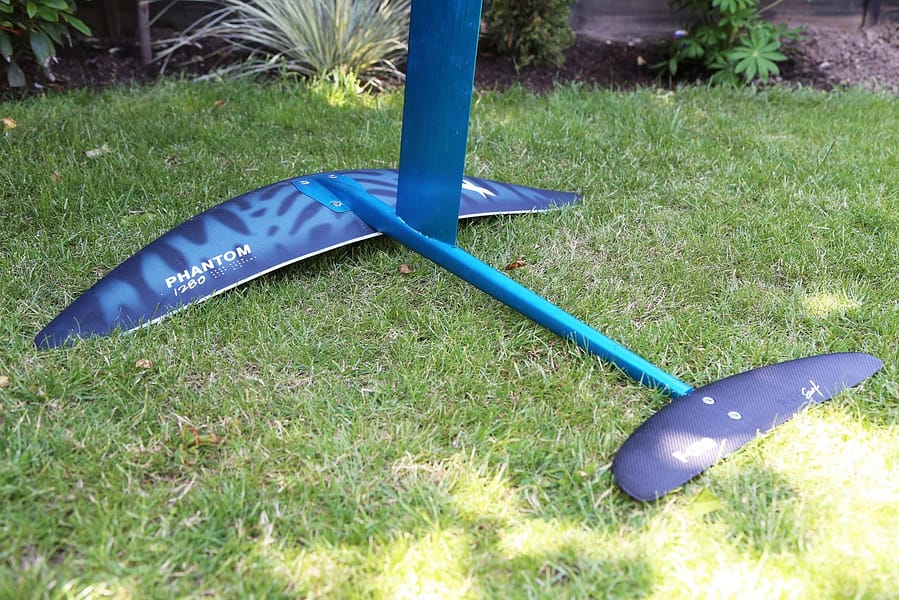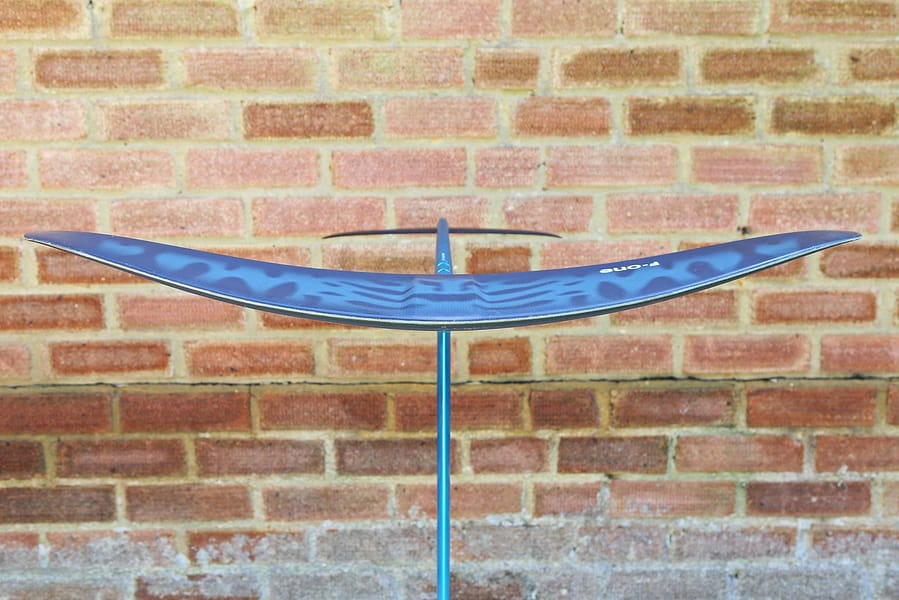Source: WingSurfWorld
TESTED BY: Jim Gaunt (WSW editor) & Rob Claisse (Progression.me)
WORDS: Jim Gaunt
I’ve had many sessions on two F-One foils, from the Phantom carbon 1780 in my early days and then the Phantom carbon 1480 for six months more recently. As I find with all F-One’s kite foils from recent seasons, the design team absolutely understand how to deliver controlled lift so well. The smooth take-off and progressive acceleration is always apparent. The Phantom carbon 1480 was a wing I was quite heart broken to part with this winter as it had been such a reliable wing across many sessions. This 1280 sounded like quite a step-down for me, and looked it too when it arrived in spring.
FCT is F-One’s new Foil Compression Technology, an innovation they say offers “impressive mechanical properties, making it particularly suited to a foil subjected to high stresses and bending loads.” Basically what you need to know is that it seems far stronger than pure carbon but yet isn’t heavy… and has this alluring camouflage look that had many wingers coming over to touch! I was going into my Phantom FCT 1280 experiences as a 70 kilo rider, with a fairly consistent 18 months of winging experience under my belt. All my sessions were on the F-One Rocket Wing V2 75L and Naish Hover 75L boards.

CALIBRATION
My first session was on a decent 20 knot day with the biggest gusts up around 28. I set the mast just a shade too far forward of centre for my first go; some of the slower speed moments where the foil still felt loaded (coming out of manoeuvres) was taking quite a bit of front foot pressure to get the foil to drive forward. Calibrating to a new foil can take a few runs, or sometimes longer, but I was pleasantly surprised that the 1280 was definitely going to offer me enough lift without first creating loads of board speed. I nudged the mast back a shade to just behind the middle of the track which was perfect. Back on the water and the top end speed seemed far more progressive than anything I’ve ridden and I soon became aware that this was going to be an ideal stronger wind wing for me (that has since added new top end to my 4.2m Strike wing, too).
TURNING
Carving is very stable and tight. It’s very easy and obvious what to do with your front foot pressure and you can turn in one tight arc. I noticed this as an immediate advantage having gone back and forth with some bigger foils in recent months, where you’re initially focussing on getting through the wind and then refocussing on tightening up the turn to finish it off. I very quickly became comfortable enough to spot a little wave and turn on to it almost immediately. Once on the wave the glide is good, but I did find that I initially needed to pump a bit more to stay with our slower rolling wind swells. The more experience I had on the 1280 though, the faster I started entering my carves, and then the less pumping I’d need while gliding as my timing and confidence seemed to be improving exponentially with each session.

Above: Constantly curved arc offers excellent handling for linking your turns… with a magic flat block in the middle Below: A neat rubber pad on top of the mast plate to protect your board – choose from plate, KF, deep KF and Tuttle connectors to fix on top of the mast for different boards.

CONFIDENCE
The FCT 1280 was still offering stability to get up and going in more average 16 – 18 knot winds on my 4.2, but then also encouraged me to start to putting the hammer down in stronger winds, actively positioning myself in more aggressive wave positions. Whats more is I wasn’t feeling fatigued half as quickly in the more demanding conditions. Bigger wings can make you feel as if you’re constantly trimming them forward and / or feathering your wing (the one you’re holding) a lot more as the foil doesn’t forgive such transference of power when already near max speed. The 1280 carries decent speed. Not kite foiling speed, but decent.

STEPPING DOWN
Where I was failing more than usual in my first sessions was my toeside tacks, but I knew I needed to carry more speed into the move; more than the 1480 and 1650 wings I’d been sessioning again more recently. As experience came, I soon adapted to focusing more on keeping my body weight directly over the board and in doing so the FCT provided much more time to sort my hands out and finish the tack than my body was initially feeling. I’ve learnt that bigger foils are great, but I think it’s good to challenge yourself and step down before your body becomes too familiar with their automatic programming. As more windy sessions came and I was riding more consistently in 25 knot conditions, I was aware just how well the Strike 4.2, 75L Rocket Wing V2 and this Phantom 1280 FCT work so well together. So tight, so connected, so balanced…. so instinctive. The tightness of my carves felt unrecognisable to just a few weeks earlier and I was afforded the casual flexibility of deciding later and later whether to carve onto a wave or not. The later I left it the less I then needed the wing at all. In fact such is the glide at speed that I could let my back hand off the wing further and further in front of the wave before turning on to it. Such a feeling of surf freedom!
“As a hydrofoil for all round use, from ocean cruising, to really pushing my level in wave riding, I’m excited for the season ahead with this. F-One have unlocked another level in the foiling game for me here.”
SUMMARY
Essentially, like all the F-One foils I’ve tried in both their wing and kite ranges, the Phantom FCT 1280 doesn’t do anything whacky. There are no quirky character traits to catch you out, instead just a very intuitive ride performance. I feel that I’ve progressed very quickly through feel and instinct. Although I’ve tried to illustrate the techniques here, I never felt like I was having to really analyse my own body movements much at the time because the Phantom 1280 FCT is smooth and well balanced. No sudden sharp up or downs means you can adapt to conditions very easily indeed. I thought that by the time I was attacking waves as forcefully as I am now, I’d probably need to be riding something smaller and be managing howling conditions. The 1280 gets me going in around 16 – 18 knots and then it’s only really the wing size that has become the limiting factor in 30+ knots. Those are the bread and butter conditions for me here in the UK that I want to be winging in. As a hydrofoil for all round use, from ocean cruising, to really pushing my level in wave riding, I’m excited for the season ahead with this. F-One have unlocked another level in the foiling game for me here.

WSW LIKED:
As well as the tight turning performance and glide, the FCT technology feels really tough, ding resistant and isn’t heavy. Bear in mind I was also using a fully aluminium mast and fuselage set-up, and I have no issues with weight at all.
WSW WOULD CHANGE: The 1280 is going to feel quite small for most intermediates who are closer to 80 kilos and above in weight. Look to the Phantom 1480 FCT for more all-round forgiveness and lift.
PHANTOM 1280 FCT BALANCE POINTS x/10:
Robust / Build: 8
Lightweight handling qualities: 7
Stability: 7.5
Rider level: Progressive intermediate – advanced
Wing range: 8.5 Smooth turns: 7.5
Tight turns: 7.5 Glide: 7.5 Ease-of-use: 8
FCT SIZES: Gravity 1800 FCT, Gravity 2200 FCT, Phantom 1480 FCT & Phantom 1280 FCT



